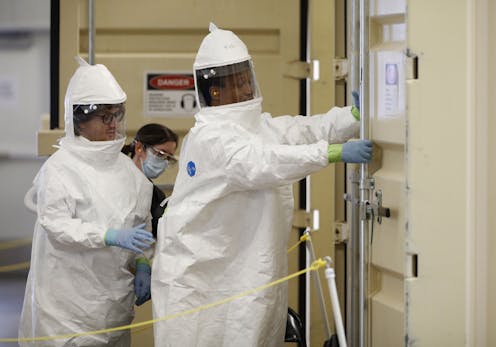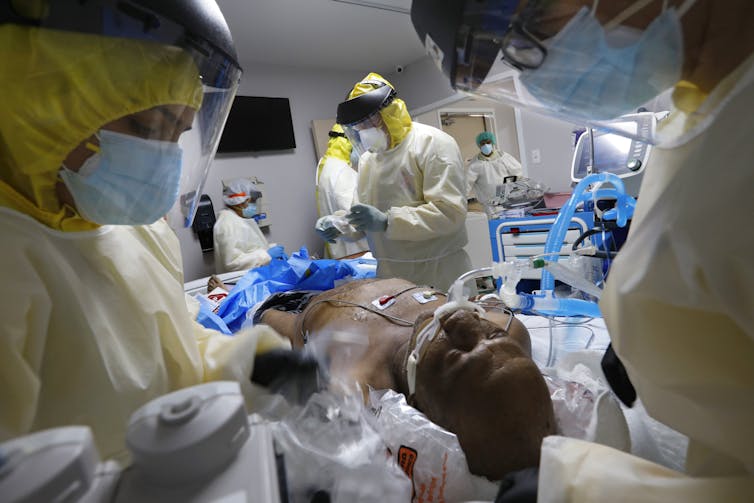The raging competition for medical supplies is not a game, but game theory can help
The toll of the pandemic has been worsened because of the shock to the global supply chain, which resulted in shortages of vital medical equipment. Could game theory help?

The world continues to reel from the pandemic and, among many other things, the shortage of medical supplies that has resulted. Yes, the world has experienced natural disasters, but they are typically limited in time duration and location. The coronavirus pandemic has severely impacted the globe for many months.
Critical medical product supply chains, in particular, have become enormously stressed due to the astronomical increase in demand, from masks to ventilators to testing supplies.
I conduct research on perishable product supply chains with applications ranging from blood to personal protective equipment. Most PPE and medical supplies have a limited lifespan and some in the U.S. National Stockpile no longer met quality standards, as reported by CNN in early May. This pandemic has shown us all that competition for these essential, yet limited, supplies is the reality.
Game theory, the study of strategies under competition, can help.

Many steps in a global supply chain
What do I mean by a supply chain? It’s the steps in a chain that a product takes to get from production to consumers.
In traditional farming communities, supply chains were no more complicated than growing tomatoes and getting them to a market in a cart. In large part because of globalization, a product supply chain now may originate in a remote town in Asia, then take on additional parts in China and be assembled there, with subsequent transportation across the ocean to Los Angeles and further shipment across the United States.
Over the past decade, the production of medical supplies has migrated to countries with low production costs. For example, China now produces half of the world’s supply of face masks. With the coronavirus originating in Wuhan, China, Chinese leaders dedicated the majority of the supply for their own use. Additional countries, including Germany, even banned the export of their locally produced personal protective and medical supplies.
Due to the dire need now for medical supplies, there has been intense competition with leaders going to extreme measures to procure them for their health care organizations. The race to acquire PPE and ventilators has resulted in large price increases, with some prices rising by more than a factor of 10.
For example, the price of N95 masks in the United States grew from US$0.38 to $5.75 each (a 1,513% increase) from pre-COVID-19 times to April 6, 2020. Isolation protective gowns experienced a price increase from $0.25 to $5.00 (a 2,000% increase). The price of reusable face shields rose from $0.50 to $4.00 (a 900% increase).
Coronavirus cases continue to rise in more than half of states. Furthermore, shortages of PPE were again reported in the United States in July.
With cases still climbing, and with additional medical and dental practices, and educational institutions, and businesses reopening, the demand for PPE will only grow.

When game theory can help
The pandemic with the novel coronavirus has spurred the development of game theory models and algorithms. Scholars in disciplines from math to business to political science use game theory to understand how people are likely to make decisions in response to actions by others.
In game theory, there are “players,” who can be organizations, firms and governments. They compete, using strategies to achieve what is best for themselves until no one can unilaterally improve upon their strategies.
Each player also faces constraints, which can include, for example, budget and time limitations. The behavior of players is captured in a computer-based mathematical model which is solved via an algorithm. Origins of game theory lie in the seminal work of the Nobel laureate in economics, and the subject of the book and movie “A Beautiful Mind,” John F. Nash Jr.
The current medical product supply chain scenario is especially challenging to model because of a common constraint to all parties who are seeking to obtain the products – mainly, limited supplies of the critically needed products.
Our research group constructed such a computer-based supply chain network game theory model to capture the competition among health care organizations for limited medical supplies.
The model has many different inputs. For example, they include the prices for the medical items charged by different suppliers; the transportation costs to points of demand, which can include taxes, tariffs, duties, and even risk. There are probability distributions – a mathematical function that gives the probabilities of the occurrence of different possible outcomes – associated with the demand for the medical items at different demand points.
Importantly, the model also includes penalties associated with shortages or surpluses, with weights on the former much higher than those for the latter. The model enables a multiplicity of scenarios, such a the addition or removal of suppliers; increased competition from additional demand points, and/or changes in the prices as well as transportation costs.
The computer-based model yields multiple insights in terms of how organizations can more effectively and economically procure critical medical supplies such as N95 masks under demand unpredictability and competition. With the addition of new demand markets, the organizations obtain fewer needed supplies, and at higher costs.
The findings from our model also confirm that in the case of coronavirus more supply points with sufficient supplies are needed to ensure that organizations have critical supplies due to competition. Governments must invest in such domestic production facilities, instead of importing and offshoring so much.
[Deep knowledge, daily. Sign up for The Conversation’s newsletter.]
As a result of this competition and limited local availability, in particular in the case of supplies such as masks and even coronavirus test kits, we are seeing more countries setting up local production sites. This is what our model proposes. Importantly, our model also quantifies how having more supplies of PPE can reduce costs, with even the loss of human lives factored in.
The pandemic will be with us for several months or longer, until a vaccine is available as well as lifesaving medical treatments. We must also be prepared for future pandemics.
Until there is a centralized authority that would allocate medical supplies such as PPE effectively, efficiently, equitably and cost-wise, game theory will remain a powerful tool to identify who wins and who loses. This will allow our nation and the world to more effectively prepare and mitigate in health care disasters.
Anna Nagurney does not work for, consult, own shares in or receive funding from any company or organization that would benefit from this article, and has disclosed no relevant affiliations beyond their academic appointment.
Read These Next
How the ‘slayer rule’ might play a role in determining who will inherit wealth from Rob Reiner and h
These rules have a long history in the United States. They played a role in the notorious murders by…
How to reduce gift-giving stress with your kids – a child psychologist’s tips for making magic and a
Depending on family circumstances and a child’s personality type, gift giving runs the gamut of fun…
The world risks forgetting one of humanity’s greatest triumphs as polio nears global eradication − 7
Polio may finally be defeated in the next 5 years. Will the world recognize what an extraordinary achievement…






